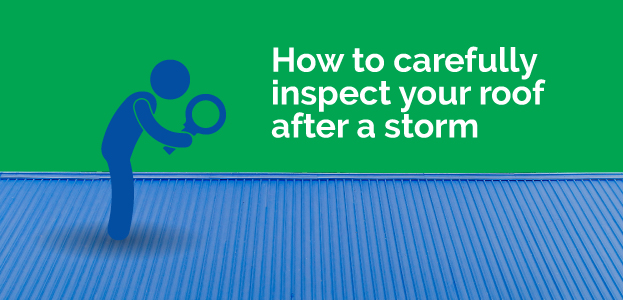
How to carefully inspect your roof after a storm
October 01st, 2018
Category: All Blogs, Maintaining your roof
Howling winds, torrential rainfall, occasional hail, snapping tree branches – your home’s roof is completely exposed to the elements, all of which can and will cause severe damage to your roof. A light thunderstorm or mild rainfall may seem harmless. But with prolonged exposure, even just a draught of wind may be enough to lift all your roof’s shingles and sling debris around it causing further destruction.
In these situations, one can never be sure just how much damage your roof can sustain. Hence it is imperative you inspect your roof and home after every storm. You must be equipped to know how to inspect your roof for damage and how to follow through.
If your roof does display signs of damage, you need to act immediately to prevent further damage. The impact from hail, pelting rainfall, falling or flying debris, tree branches, etc. damage your roof’s shingles making your roof susceptible to water leaks. All of this can be prevented with a few simple checks you can do by yourself after a heavy rainstorm. Here’s a handy roof inspection checklist that will help you if you’re wondering what to look for when inspecting your roof.
Inside your loft
If your loft is accessible, it would be a good idea to begin there, in the daytime. The first and surest sign of roof damage would be a spot of sunlight streaming in through the plywood decking. This indicates holes in your roof and other severe damage that requires immediate repair. If you can’t see any visible holes, use a torchlight to thoroughly inspect the decking for dark stains or streaks or sagging, all of which are caused by moisture.
Outside and around your home
At the ground level, you will be able to see the most if not all the damage your roof has sustained. While walking around your house and examining your roof, you might come across one or several signs of damage like missing shingles, which should be replaced as soon as possible. Cracked or curled shingles are caused by flying debris or powerful winds. Dark patches occur when granules have come off single or multiple shingles. Not only do they affect your roof’s aesthetic, but these patches also leave your roof vulnerable to water leaks and sun damage.
Another possibility of roof damage is a bent or detached flashing. Your roof’s flashing keeps water out of your chimney, vents and other penetrations. The smallest crack should immediately be sealed to avoid further damage and leaks.
If you see debris lying on your roof or in the gutters and downspouts, clear it away immediately. You may think it isn’t causing any damage, but the leaves and branches and dirt could be covering up cracks or other signs of damage.
Using a ladder
Exercise caution when climbing up a ladder to inspect your roof. Also, ensure that the weather conditions allow you to do so. Once you’re eye level with your roof, you should be able to notice things like loose nails or nails raised above shingles. Fix them immediately because the next storm might cause them to come off completely. In colder regions, gutter debris can turn into ice dams during winter. To help prevent this, clean out your gutters periodically. You could reach out to your roofing contractor for the same service if you feel you won’t be able to do the job right.
Document what you find
If you are unaware of what a potential roofing problem looks like, or would instead not venture out of your home, take plenty of pictures of your roof and surrounding areas. If anything seems amiss, regardless of how subtle or seemingly insignificant, document it immediately, and these could be signs of underlying problems. This will even come in handy if you’re hiring professionals.
Reach out to the professionals
If your roof has sustained damage due to a recent rainstorm, don’t hesitate to reach out to the professionals. You can get in touch with the roofing experts at Dura Roof. Our team has the equipment and expertise required to deal with all kinds of roof damage and will be able to determine the type of damage caused and recommend the best course of action.
Leave a Comment

1 Response received for this post